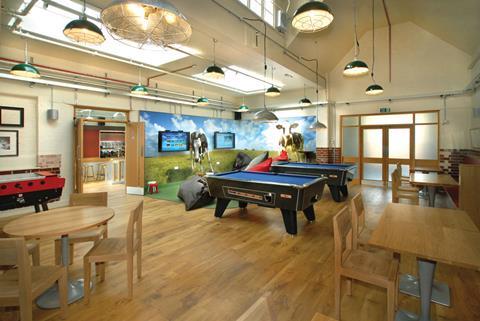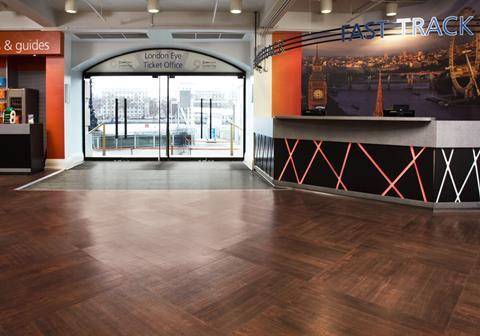Vinyl floor tiles present an alternative to natural flooring materials and to carpet, sheet vinyl and laminate. As a highly durable surface, they are suitable for use in a range of leisure projects. This module is sponsored by Karndean Designflooring
Click here to take the CPD module.
How to use this module: BD Reviews’ free continuing professional development distance learning programme is open to everyone who wants to develop and improve their professional knowledge and skills. These modules can contribute to your annual programme of CPD activity to help you maintain membership of professional institutions and bodies. All you have to do is read this module then take the questions via the link above or at the bottom of the page.
Module 11 deadline: December 9 2011
Manufacturing vinyl floor tiles
Vinyl floor tiles are manufac-tured from a number of layers that create a highly durable flooring surface with many benefits compared to traditional materials.
To create each layer, PVC, plasticisers and stabilisers are blended in an industrial mixer. This molten material is exposed to heat and pressure and passed through a series of rollers to produce flat sheets of material, a process known as “calendering”.
The sheets are laminated together to produce one sheet. During this process, the surface texture is applied to the top layer, using metal plates to emboss the pattern on to the sheet.
The sheet then undergoes “annealing”, which removes internal stresses by controlled heating and cooling, to ensure the product is dimensionally stable. The product is then cut into tiles, strips or designs and packaged for sale.
Below are the components of Karndean Designflooring’s Luxury Vinyl Tiles and the raw materials that make up the tiles.

Components
- Base layer: designed to adhere to the subfloor.
- Middle layer: the tile’s core, providing strength and stability.
- Photographic film: the image you see.
- Wear layer: a hard-wearing but transparent layer embossed with a texture for grip and to enhance the visual effect. The thickness of this determines the durability of the floor. Generally, a rougher wear layer will increase the slip resistance.
- Polyurethane coating: a thin coating that seals the product and adds durability. There is no need to seal the product after installation, saving time and money.
Raw materials
- Recycled PVC: closed-loop recycling means that any manufacturing waste goes back into the system.
- Fillers: reinforcement in the backing and middle layers to provide mechanical strength.
- Stabilisers: to prevent the material from degrading.
- Plasticisers: to make the material more flexible and durable.
- Photographic film: on to which the design is printed to give a realistic appearance.
- Polyurethane coating: applied to keep the product in good condition and help prevent scratching.
Standards and ratings for vinyl floor tiles

The European standard EN685 defines the suitability of a product for a certain application. Broadly, the classification is determined by the quality of the wear layer and the thickness of a product. Classifications are as follows:
- Domestic application: 21, 22, 23
- Commercial application: 31, 32, 33, 34
- Light industrial application: 41, 42, 43
A number of regulations govern the required slip resistance of flooring materials.
BS 7976
Also known as the Pendulum Test, this is the Health & Safety Executive’s preferred method of testing. There is an extensive history of correlation to slip incidents and the standard is recognised by independent experts as the most accurate measure of slip resistance. Floor products are tested both wet and dry.
Rz measurement
Not considered a slip test in its own right, but surface roughness measurements taken in support of the pendulum assessment can provide additional information about the floor surface’s ability to cope with contaminants, such as milk and soft drinks.
DIN 51130
Ramp testing is a widely recognised German method that produces an “R value”, ranging from 9 to 13.
This method involves human subjects walking backwards and forwards on a surface contaminated by motor oil.
The surface is gradually inclined and the angle at which the first slip occurs determines the rating. An R9-rated floor (non-slip at an angle of 6-10 degrees) is more than adequate for commercial applications where a safety floor is not required.
Vinyl floor tiles perform particularly well in the dry, and most products would achieve an R9 or R10 rating. It is only in some specialist designs, such as mosaics, where the R9 rating is not achieved.
Building Regulations
Part M states only that floors should be slip resistant but does not give a figure or recommend a testing method. The HSE prefers the Pendulum Test.
By selecting a floor that carries the CE EN14041 mark, specifiers can ensure that projects meet regulations.
This includes the EN13893 friction test on dry surfaces (known as the “DS” test) as well as tests on fire spread.
Benefits of vinyl floor tiles
Durability
Vinyl tile products will not splinter or crack, which means little need for repairs and no unsightly damage. A vinyl tiled floor does not shrink, expand or curl as much as natural wood or laminate flooring when exposed to moisture and temperature variations, and is resistant to stains, indentation and
non-corrosive liquids.
Hygienic properties
Vinyl flooring products will not harbour dirt or dust mites, helping to ensure cleanliness and maintain a healthy and safe environment. There is no need for chemical or steam cleaning, as with carpets, and no grout lines, as with stone, which can harbour germs.
Ease of installation
Because vinyl flooring is relatively thin (typically 2-4mm), there is no need for major remedial work such as resizing doors and moving pipework for new flooring. Vinyl flooring is easier to cut and install in commercial environments. It is much lighter to handle than natural products such as stone, minimising health and safety risks on site. Vinyl tiles are also easier to repair and replace in comparison to sheet vinyl products, stone or wood.
Acoustic performance
Vinyl flooring is quieter underfoot than stone, wood or laminate.
Design flexibility
Vinyl floor tiles offer a faithful representation of natural products. Due to the product’s consistent thickness and ease with which it is cut, innovative designs can be created quickly. Directional indicators or logos can be embedded for leisure or retail environments.
Environmental ratings

BRE Global
The Green Guide to Specification scheme rates the sustainability of products from A+ to E, taking into account the sector in which they are to be installed. On public-sector projects, buildings must meet minimum sustainability standards and government funding will be linked to achieving a certain BREEAM rating. Karn-dean Designflooring’s luxury vinyl tiles achieve a generic A or A+ rating in BRE Global’s Green Guide to specification depending on the sector and application.
Ska rating
The Royal Institution of Chartered Surveyors (RICS) developed the Ska system to help assess the environmental impact of fit-out and refurbishment projects. The assessment only takes into account the new materials which are used for soft floor coverings.
To qualify, soft floor coverings must meet at least one of the following criteria: are reused; are manufactured with at least 80% recycled content; have at least an A rating in the BRE’s Green Guide to Specification; are sourced from a company to which they can be returned at the end of their life; are supplied with an environ-mental product declaration written in accor-dance with ISO 14025 standards.
Life Cycle Assessment
The three areas considered under the BRE’s Life Cycle Assessment criteria are energy use, waste and ozone pollution. Karndean Designflooring’s vinyl flooring tiles perform well because PVC is the least energy-intensive polymer to manufac-ture, factory waste is recycled in closed-loop systems, and the product has a low Volatile Organic Compound (VOC) emissions rating.
Vinyl flooring also performs well at Life Cycle Assessment because it maintains its appear-ance under heavy use, keeping maintenance costs to minimum, and does not need harmful cleaning agents. Specifying vinyl floor tiles also reduces waste at installation. Karndean Designflooring’s products are fitted to the walls with minimum wastage (typically 5%) and offcuts are 100% recyclable.
Other considerations for specifying vinyl floor tile products
There are also a number of technical considerations to take into account when specifying a vinyl floor tile product.
Wear layer
The thicker the wear layer, the more durable the product. For commercial applications, a wear layer of 0.55mm is required. For areas with heavier traffic, a 0.7mm layer is preferable. For domestic use, a 0.3mm wear layer is generally adequate.
Emboss
Two emboss types are used in Karndean Designflooring’s vinyl floor tiles: a randomly milled texture, and a Registered Emboss. The first provides a varying texture, from a light emboss that barely affects the aesthetics of the product, to a stronger texture that offers a more rustic appearance or even mimics a hand-finished texture.
In a Registered Emboss, the texture matches (is “registered” to) the image used in the print layer. For example, the knot in a plank of wood can be felt as well as seen.
Bevel
Where a product has a thicker wear layer, it is possible to shave the edge of the plank or tile to produce a bevelled edge. When the product is laid, this adds a third dimension to the appearance, reflecting the light.
Postscript
To complete this CPD, read the module and click here to take the test online. If you experience any problems viewing the test online, contact bdreviews.cpd@ubm.com
MODULE 11 DEADLINE: December 9 2011
Privacy policy
Information you supply to UBM Information Ltd may be used for publication and also to provide you with information about our products or services in the form of direct marketing by email, telephone, fax or post. Information may also be made available to third parties.
“UBM PLC” may send updates about BD CPD and other relevant UBM products and services. By providing your email address you consent to being contacted by email by “UBM Information Ltd” or other third parties.
If at any time you no longer wish to receive anything from UBM PLC or to have your data made available to third parties, please write to the Data Protection Coordinator, UBM PLC, FREEPOST LON 15637, Tonbridge, TN9 1BR, Freephone 0800 279 0357 or email ubmidpa@ubm.com
Sponsor
For more information, go to www.karndean-commercial.co.uk
















No comments yet